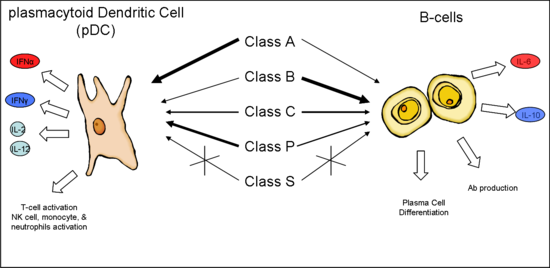CpG oligodeoxynucleotide

CpG oligodeoxynucleotides (or CpG ODN) are short single-stranded synthetic
History
Since 1893, it has been recognized that
Structural features
Synthetic CpG ODN differ from microbial DNA in that they have a partially or completely
Class A
One of the first Class A ODN, ODN 2216, was described in 2001 by Krug et al.[10] This class of ODN was distinctly different from the previously described Class B ODN (i.e., ODN 2006) in that it stimulated the production of large amounts of Type I interferons, the most important one being IFNα, and induced the maturation of plasmacytoid dendritic cells. Class A ODN are also strong activators of NK cells through indirect cytokine signaling.
Structural features defining Class A ODN:
- The presences of a poly G sequence at the 5' end, the 3' end, or both
- An internal palindrome sequence
- GC dinucleotides contained within the internal palindrome
- A partially PS-modified backbone
Class A ODN typically contain 7 to 10 PS-modified bases at one or both ends that resist degradation by nucleases and increase the longevity of the ODN. The above rules strictly define the class, but variability of the sequence within these "rules" is possible. It should also be noted that changes to the sequence will affect the magnitude of the response. For example, the internal palindrome sequence can be 4 to 8 base pairs in length and vary in the order of bases, however the pattern, 5'-Pu Pu CG Pu Py CG Py Py-3', was found to be the most active when compared to several other sequences. The poly G tail found at either end of the DNA strand can vary in length and even number (Type D only have a poly G sequence on the 3'end), but its presence is critical to the activity of the molecule.[citation needed]
Class B
Krieg et al. was the first to describe Class B ODN in 1995.[6] Class B ODN (i.e. ODN 2007) are strong stimulators of human B cell and monocyte maturation. They also stimulate the maturation of pDC but to a lesser extent than Class A ODN and very small amounts of IFNα.[citation needed]
Structural features defining Class B ODN:
- One or more 6mer CpG motif 5'-Pu Py C G Py Pu-3'
- A fully phosphorothioated (PS-modified) backbone
- Generally 18 to 28 nucleotides in length
The strongest ODN in this class have three 6mer sequences.[11] B ODN have been studied extensively as therapeutic agents because of their ability to induce a strong humoral immune response, making them ideal as a vaccine adjuvant.
